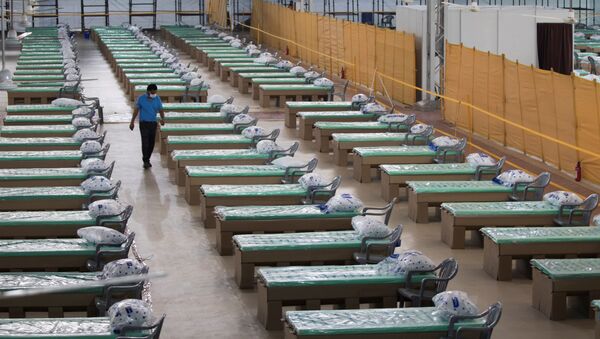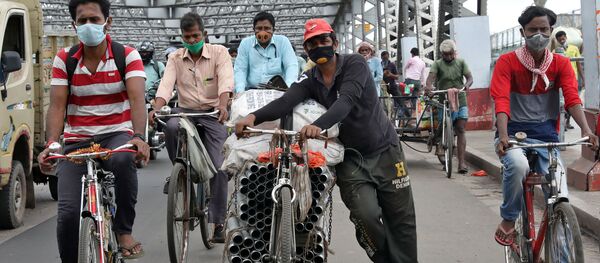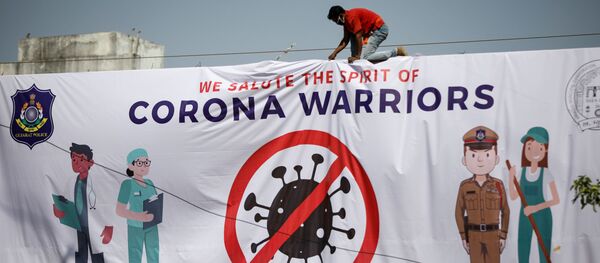Delhi has achieved an impressive COVID-19 recovery rate of 75% against the national average of 62.93%, according to the Indian health ministry. In another positive milestone, the number of active cases has declined by 29% with a gradual daily fall in cases since July.
Lok Nayak hospital is the frontline for COVID-19 fight in Delhi, seeing 800-1200 infected patients admitted for treatment daily until June, but since then the strain on hospital beds has declined significantly.
“Earlier we use to have over 120 cases per day, now we are admitting about 50-60 patients daily,” Dr Suresh Kumar, Medical Director of Lok Nayak Jai Prakash hospital says.
Delhi - a city of some 20 million people – faced a shortage of beds from May to early June with people queuing up outside government hospitals.
Until early June there were a total 8,049 beds in Delhi’s government and private hospitals that were treating coronavirus patients. The capital now has 15,330 hospital beds, out of which 9,217 beds are in dedicated COVID care centres and 544 in COVID healthcare centres. Nevertheless, with the city witnessing a sharp fall in coronavirus patients, almost 11,000 hospital beds remain vacant.
Indian Prime Minister Narendra Modi has appreciated Delhi’s efforts in containing the deadly virus and called for replicating the capital’s strategy in other states.
Aggressive Measures Adopted by Delhi
Delhi, on Monday, reported fewer than 1,250 new infections, the lowest rise in 24 hours since 1 June. The Delhi government has been following a policy of home isolation, mass testing, sealing of containment zones and fast-paced turning of restaurants, hotels and private hospitals into COVID-19 treatment facilities.
“Delhi is in a better position with respect to infrastructure than we were in June. Fast-paced testing, strictness in containment zones, contact tracing and medical support to patients in home isolation has benefited the capital,” said Delhi Health Department official.
Despite the stigma attached to the disease and fear of isolation in close-nit community like India, the home isolation strategy turned out a success in Delhi. As per the analysis by the health department, zero deaths were reported in patients in home isolation during the first week of July.
“Of 691 deaths that took place during the last fortnight, only seven deaths took place in home isolation (between June 24 and June 30). Not a single patient in home isolation died in July. We can attribute this to the chief minister’s decision to distribute pulse oximeters to all patients in home isolation. The use of these oximeters alerts the patients of a drop in oxygen levels, which is an early sign of deteriorating health,” claimed the Delhi government.
Delhi Chief Minister Arvind Kejriwal on 24 June expedited the capital’s testing capacity and announced a blanket testing of every household in the capital in an unprecedented 12-day campaign. In the last 15 days, Delhi has been routinely testing between 20,000 to 25,000 every day while Mumbai is testing just 4,000 people per day.
Till now Delhi has conducted 789,853 tests out which 9443 are RTPCR tests and 11,793 Rapid antigen tests, which are less sensitive but quick.
Too Soon To Be Complacent
Dr. Ritu Saxena, the Medical Superintendent of Lok Nayak Hospital says that the medics and civil authorities have to stay prepared for the worst despite the situation being under control as the battle is still on.
“The situation in Delhi is under control. The number of patients coming to hospital has declined. Earlier census, total COVID-19 in hospital, shot up to 800-1,200 per day, it has now declined to 600. We are getting an average of 60 patients daily,” Dr Ritu Saxena, the Medical Superintendent of Lok Nayak in Delhi told Sputnik.
From the fifth worst country in June, India placed at the third position in highest infection cases across the world, trailing Brazil which has 1,887,959 cases and the US with 3,480,044.
Testing Remains Achilles' heel
India’s sample testing for COVID-19 cases has reached 11 million mark as per India's Ministry of Health and Family Welfare, which is one of the lowest per capita testing rates. As per data compiled by Johns Hopkins University, India is conducting 190 tests per million inhabitants.
China, whose caseload remained stagnant at 85,000, conducted more than 90 million tests while the US with over 3,480,097 cases conducted more than 38 million tests.
The Indian government explains the debacle low testing rate by saying that the country has increased its capacity from just 101 labs at the beginning of pandemic in March to 1,400 testing facilities now.
“The World Health Organisation underlines the need for comprehensive surveillance and testing of suspected COVID-19 patients. They elaborate the concept of comprehensive as testing 140 people per day, per million,” said the Indian health ministry.




